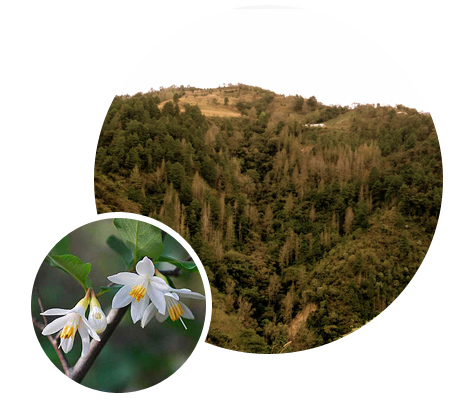As a natural raw material, styrax can be used in a multiple number of applications. Even if it is an important ingredient in perfume compositions, it can also be used as an active ingredient in cosmetics and even in pharmaceutics.
Topping of with a light styrene plastic note, it gives way to a soft cinnamic body with a balsamic character. Fruity and honey aromas are in the continuous gradations of its smell. It is considered under the amber family due to its leathery and animalic tones that are combined with an indulgent floral touch.
Liquidambar styraciflua L, is a tree that is mainly present in the mountain region of the department of Olancho in Honduras. It is also present in important volumes in other regions of the country and even at some degree in the northern mountain ranges of El Salvador.
The use of styrax gives aromatic blends a gourmand spicy tone that goes great in amber compositions. It can also be used as a fixative. It is considered as an important note in the chypre and oriental family, where it is often used. Due to its dry and smoky tonalities, it is used in bold leather compositions. You can apply styrax whenever a resinous balsamic note is called for due to its unmistakable incense like facets evocative of glue and cinnamon. It is a note that combines particularly well with woody scents. It also conglomerates well with other notes such as benzoin, vanilla, Peru balsam and cinnamon. Softens and enhances the bottom notes of floral compositions.
Styrax has been historically used since before the time of the colony for medical preparations. Some of its active properties are: antiseptic, carminative, diuretic, expectorant, parasiticide, poultice, salve, sedative, stimulant, vulnerary, anti-‐inflammatory, anti-‐microbial and wound healing due to its aid in skin regeneration.
It is also used in food aromas as a fixative. Styrax can similarly be engaged as a stabilizer in some pastry formulations.
Extraction process
Extraction from the tree start by making cuts around the stem of the trees. The length of each incision is of around 15 cm long with a depth of 3 to 4 cm. It is a diagonal cut of 45° since what the resin needs to accumulate in said cavity so that then you can collect it in a monthly fashion. What you obtain is then a mixture of resin, water, insects and vegetable residues.
An artisanal purification takes place in the fields: The resin is heated on top of firewood in until the unwanted residues start to float. This is separated but the resin still has some water in it. Some of the exporters therefore continue evaporating the water or getting rid of it through other processes like centrifugation.
![]() Download Technical Data Sheet.
Download Technical Data Sheet.
![]() Download Material Safety Data Sheet.
Download Material Safety Data Sheet.
![]() Download Technical Data Sheet 2018
Download Technical Data Sheet 2018
[ninja_form id=1]






